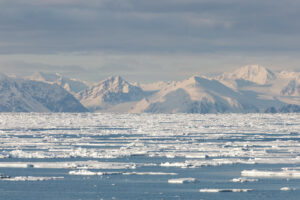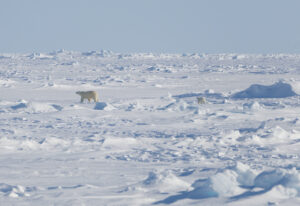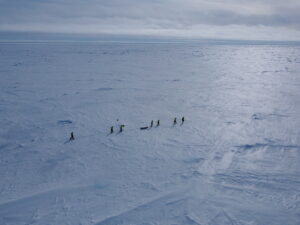An Introduction to Sea Ice Observation

Climate change is occurring more rapidly in the polar regions than elsewhere across Earth1 due to a phenomenon called ‘Arctic Amplification’. Sea ice in particular is regarded as a key indicator of climate change, and recent trends in both the Arctic2 and Antarctic3 suggest that warming at the poles is leading to dramatic changes in sea ice extent, thickness, and volume. Arctic sea ice age is also one of the most observable results of climate change; we are witnessing a transition to a younger ice pack, where the majority of ice forms and melts within one year. In the past decade, there has been an almost complete disappearance of sea ice greater than four years old4.

Sea ice in front of Svalbard 2023-ICredit: Nicolas Michalezyk
This transition to a thinner, younger ice pack means the ice will be more fragile and likely to melt. Sea ice is an important habitat, hosting and supporting diverse species from algae to whales5 and polar bears. Therefore, these changes have implications not only for ocean and atmospheric circulation, but also for the local indigenous communities and the species that rely on sea ice.

Polar Bears on Sea Ice 2023-Credit: Nicolas Michalezyk
The remote and hazardous nature of these environments mean they are challenging to study on-site at a large scale. We therefore rely on satellites to gather high-resolution and near-continuous coverage of these high-latitude environments. The invaluable network of satellites orbiting our Earth gather data in a variety of ways, including passive microwave, radar and laser altimetry, optical imagery, and synthetic aperture radar. Ensuring the continuation of these missions and the varied ways in which we collect data is essential for our understanding of these rapidly changing regions.

Amy Swiggs and colleagues on sea ice in the Yermak Plateau, Arctic, May 2023-Credit Carmen Nab
A particularly important part of polar satellite observation is ‘calibration and validation’, where we travel to these remote regions and take measurements when the satellites are overhead. We can then verify that what we find on-site is being accurately represented by the satellite. These campaigns represent international efforts between different research institutes and space agencies, such as NASA and the European Space Agency, the results of which can confirm if our satellite observations are accurate. This enables us to better understand what has happened and predict what might happen in the future.
Want to Know More?
If you’d like to explore the data yourself or learn more about how we use satellites to observe the polar regions, there are some great resources available for both students and teachers:
Sat School is a fantastic outreach resources for teachers and students, with resources and lesson plans about Earth Observation and Environmental Science.
Accessible Arctic sea ice thickness and volume data is available here from the UK Earth Observation Climate Information Service provided by the Centre for Polar Observation and Modelling.
Please get in touch if you need any help processing or understanding the data. If you would like to know more about getting into research, or how I entered the polar science field, please do get in touch. I’m extremely passionate about empowering young people and women to enter polar and climate science. There are a lot of schemes and internships available that I wish I had known about sooner. Don’t let imposter syndrome get the better of you – I certainly did not think I was good enough at Maths or Physics to be where I am today, but research is best when it involves science from many backgrounds.
About the Author
Amy Swiggs is a PhD Researcher with the Centre for Polar Observation and Modelling (CPOM) at Northumbria University, Newcastle. Her research focuses on observing sea ice from space using satellite observations. She uses this data to generate information on sea ice thickness, volume, and trends in the Arctic sea ice pack. Amy has conducted fieldwork in Greenland and the Arctic Ocean for satellite validation and in-situ sea ice observation, and is currently conducting a research visit with European Space Agency in Italy. Amy is also part of the United Nations Ocean Decade BIOPOLE project which investigates how climate change in the polar regions influences global carbon cycling and marine productivity. amy.swiggs@northumbria.ac.uk
References
(1) Rantanen, M., Karpechko, A.Y., Lipponen, A., Nordling, K., Hyvärinen, O., Ruosteenoja, K., Vihma, T., Laaksonen, A. (2022). The Arctic has warmed nearly four times faster than the globe since 1979. Nature Communications Earth and Environment, 3(168).
(2) Meier, W., Stroeve, J. (2022). An Updated Assessment of The Changing Arctic Sea Ice Cover, Oceanography, 35(3-4).
(3) Purich, A., Doddridge, E.W. (2023). Record low Antarctic sea ice coverage indicates a new sea ice state. Nature Communications Earth and Environment, 4(314).
(4) Tschudi, M., Meier, W., Stewart, J. (2020). An enhancement to sea ice motion and age products. The Cryosphere, 14(5), 1519-1536.
(5) Lannuzel, D., Tedesco, L., Van Leeuwe, M. A., Campbell, K., Flores, H., Delille, B., Miller, L. A., Stefels, J., Assmy, P., Bose, P., Brown, K. A., Castellani, G., Chierici, M., Crabeck, O., Damm, E., Else, B., Fransson, A., Fripiat, F., Geilfus, N-X., Jacques, C., Jones, E. V., Kaartokallio, H., Kotovitch, M., Meiners, K. M., Moreau, S., Nomura, D., Peeken, I., Rintala, J-M., Steiner, N., Tison, J-L., Vancoppenolle, M., Van Der Linden, F., Vichi, M., Wongpan, P. (2020). The future of Arctic sea-ice biogeochemistry and ice-associated ecosystems. Nature Climate Change, 10(11), 983–992.
Past guest blogs:
Past guest blogs from previous months can be found under "News: categories - past guest blogs", or by following this link https://www.geographysouthwest.co.uk/category/past-guest-blogs/
